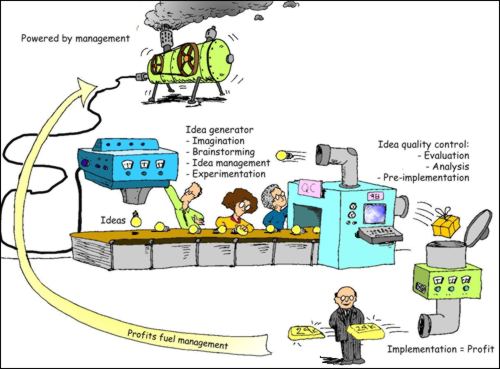“The gravitational imperative of economic flow in the arrangement requires the poorest countries in the world to keep the factories and industries in much richer countries humming and in effect finance the economic prosperity of the richer countries. It is not a rational state of affairs and confounds even the most basic logic.”
 African countries can prosper in this generation because every Africa country, from the smallest in landmass and population to the largest has enough resources within its borders to engineer economic and social prosperity. It requires acquiescing to voices of reason and applying their proffered wisdom to the challenges that are obscuring the path to prosperity in each society and country. Everything that African countries need can be acquired by applying creativity, which is a derivative of wisdom. As an example, let us examine the state of trade and economic development. Trade between African countries is minimal in comparison to trade between African countries and their colonial ruler, on one hand, and with the world in general. The composition of the trade has been African countries supplying raw materials and others supplying manufactured and processed goods to African countries. The gravitational imperative of economic flow in the arrangement requires the poorest countries in the world to keep the factories and industries in much richer countries humming and in effect finance the economic prosperity of the richer countries. It is not a rational state of affairs and confounds even the most basic logic. Internal and external infrastructure for trade is, to put it kindly, poor. In many countries power to light homes and to run industries is of such premium that generators are a major import product. In order to do business in many African countries, part of the start-up costs involves a line item for electrical power generator, even if your business is processing mangoes or manufacturing ballpoint pens. Pipe borne water supply, another example, is a luxury in many countries.
African countries can prosper in this generation because every Africa country, from the smallest in landmass and population to the largest has enough resources within its borders to engineer economic and social prosperity. It requires acquiescing to voices of reason and applying their proffered wisdom to the challenges that are obscuring the path to prosperity in each society and country. Everything that African countries need can be acquired by applying creativity, which is a derivative of wisdom. As an example, let us examine the state of trade and economic development. Trade between African countries is minimal in comparison to trade between African countries and their colonial ruler, on one hand, and with the world in general. The composition of the trade has been African countries supplying raw materials and others supplying manufactured and processed goods to African countries. The gravitational imperative of economic flow in the arrangement requires the poorest countries in the world to keep the factories and industries in much richer countries humming and in effect finance the economic prosperity of the richer countries. It is not a rational state of affairs and confounds even the most basic logic. Internal and external infrastructure for trade is, to put it kindly, poor. In many countries power to light homes and to run industries is of such premium that generators are a major import product. In order to do business in many African countries, part of the start-up costs involves a line item for electrical power generator, even if your business is processing mangoes or manufacturing ballpoint pens. Pipe borne water supply, another example, is a luxury in many countries.
Trade between African countries can be vastly expanded through the use of unconventional trade techniques. Africa countries can increase the volume of manufacturing activity in their countries immediately. Conversion of African exports from raw materials to semi-finished or finished goods can be vastly accelerated. Infrastructure can become a major economic development engine in every country, rather than a hindrance to development. African countries can become a haven for solar power so that future energy for the countries will be the cheapest in the world. All of the foregoing can be achieved through aggressive leveraging of creative trade techniques.
What am I referring to as creative trade? It is trade that is unconventional but is applicable to certain economic or business environments and situations. Leverage, for our purpose, is deriving maximum advantage from every asset in our possession. For example, when South Korea decided to build a Steel Plant, it could not raise the money it needed to build it from conventional sources like the World Bank and other multilateral lending organizations that are supposed to support development. I should add that the same organizations had no problem lending to African nations for industrial schemes that have now become known as “white elephant” schemes that were designed to siphon resources from their shallow treasuries. South Korean leader of the day, Park Chung Hee was committed to building a steel mill because he believed it would establish the foundation for South Korea’s economic prosperity and it has. The inability to secure financing, however, threatened the project. South Korea was between a rock and a hard place as it were because they were also unable to get the funds from governments—including patron-governments like the United States—because no one believed that South Korea, which possessed no significant inputs needed for steel production, should be making steel. Nobody that is, except the South Koreans and their leader. South Korea turned to Japan and negotiated something akin to a barter deal. They requested for funds being sought from Japan as reparation for atrocities committed during Japanese occupation of South Korea to be converted to development loans and grants. The funds along with supplier credits were then used for purchasing of Japanese equipment and expertise that enabled South Korea to build the steel plant.

Another example of leverage and thinking outside the box is the experience of the United States early in her development. The United States was comprised of vast lands in the western hemisphere that was not only far from the metropolitan eastern part which had been settled first, but also difficult to travel to because there was no formal traversable link between east and west. The only means of travel was by horse-drawn carriage through rivers, desert, and mountainous passage in a perilous affair that was fraught with mortal danger and attendant high fatality. Two mountainous passes, the Rocky Mountains, and the Sierra Nevada had to be scaled. The largest of which, the Rocky Mountains, rise more than 14,000 feet at its peak. As a result of public clamor for a better way to travel the journey and California’s contemplation of secession, pressure was on the Congress of the United States to do something. Also integral to the motivation of the US Congress and the states was the desire to connect the Eastern half with the West in order to open the hinterland and other then-remote parts of the country to economic development. Building a transcontinental railroad was, at the time, the only way to bridge the distance. The US government created an incentive arrangement that would make it desirable for entrepreneurs to take on the enormous challenge and risk of building a transcontinental rail system that would link the eastern and western halves of the United States. They did it by issuing US government bonds at 6% to the railroad entrepreneurs. For every mile of rail that was laid, the railroad entrepreneurs received a specific amount in US Government bonds. The recipients turned around and leveraged the bonds for financing railroads. Congress also awarded tracts of land around the track and at strategic points so the railroads could build stations. The excess land was sold to generate additional revenues.
“President Abraham Lincoln structured the railroad’s contract with both generosity and constraint. Railroad builders were given 6,400 acres of land for every mile of track laid, and $48,000 in government bonds for every mile completed. But there were strictures: the government withheld 20% of the bonds until the entire railroad was in working order, and would not release any money to either company until 40 miles of operative railroad was complete. And further, if the railroad between Missouri and Sacramento were not completed within 12 years, all the assets would be forfeited…. By 1880 (the railroad was completed in 1869), cargo carried amounted to US $50 million per year. Instead of months, it took just 10 days to cross the country. The transcontinental railroad, like the Erie Canal of a previous era, exponentially increased commerce and communication.”1
For American entrepreneurs, the Transcontinental Railroad is a classic case of business at work, building and meeting the needs of society at large. It gave some an opportunity to build great wealth and some did. Fortunes were made but losses were also incurred. Instead of months that it took to deliver cargo from the eastern United States to the west, it now took days. What a difference that must have made for the people who experienced the transformative ingenuity of creative trade and enterprising entrepreneurship. Give the Congress and the late then-President Abraham Lincoln credit for willing to risk public displeasure in the creative financing of the transcontinental railroad project. The government gave bonds (debt instrument carrying the full faith and credit of the United States) to the railroad entrepreneurs (risk takers); the entrepreneurs (in turn) used the bonds as collateral to leverage foreign and domestic capital to fund their construction. Using other people’s money, the United States was able to fund one of the largest construction projects in its history. Stroke of genius! It is arguable that genius is always couched in the simple strokes of a grand initiative.

Another example of creative trade is in the trade history of the former Soviet Union. It is a transaction that has come to be known as Siberian-Gas-For-Pipes Trade. The Soviet Union had gas reserves that it wanted to bring to market. There were several problems with the idea. First, the Soviet Union was broke so it had no money to finance the construction of the pipeline. Second, the Soviet Union was locked in a political battle of wills with western countries for global ideological supremacy, so getting help from the enemy was not in the cards. Third, there was the issue of how to get the gas to market. Even if the Soviet Union had the money, it did not have the know-how or, better put, the ways and means of engineering a way to convey the gas to market. The solution was to engineer a trade arrangement that did not require the Soviet Union to pay anything upfront but rather to tie payment for the project to the proceeds from gas exports to hard currency markets. Political consideration was swept aside when the economic and financial realities became front and center. The participating European countries needed the gas supplies from the Soviet Union. They also needed the jobs and revenues that the project would create for their engineering firms and equipment (pipes and pumping stations) suppliers to the project, some of which were subsidiaries of US companies. The United States under the late then-President Ronald Reagan objected strenuously to the transaction mainly because his advisers counselled that it would create a breach in the arsenal of NATO2 countries if they were beholden to the Soviet Union for energy. In the end, the deal was consummated over the objections of the U.S government because the realpolitik of jobs, money, cheap energy and the economic benefits of the no-money-down-gas-for-pipes-deal for the Soviet Union won the argument. Gas from the deal is still flowing to the countries today.
The simple but effective engineering of the trade structure of the deal made it possible because it eliminated the importance of having cash available to purchase the know-how and equipment on the part of Soviet Union. This was accomplished by securing commitments from financially strong and reputable end-users of gas on the part of the European countries. In other words, to pay for construction of the gas supply pipeline, the Soviet Union entered long term contracts for the supply of gas to energy companies in the west. In the contract, the companies would receive gas from the pipeline and make payments into a specially designated escrow account set up for the purpose and which would be managed by a party designated to distribute funds to pay for the loans made to build the system. Once the bridge of political and economic risk insurance needed to facilitate the flow of loan funds was built, the banking system in the primary participating countries (U.K., Germany, France and Italy) made the money available. The benefit to the Soviet Union is that in addition to receiving revenues from gas exports right away, albeit reduced due to loan service payments for the financing of the pipeline, it was now in possession of a hard asset worth billions of dollars that would be producing revenue for generations after the payment for the pipeline was complete, thereby vastly expanding its future revenue flow.3
Another tremendous trade engineering scheme is a transaction that has become known as the Saudi “Peace Shield.” In this arrangement, Saudi Arabia purchased an air defense system from American prime contractors, including Boeing, for more than $1.3 billion dollars. In return, Saudi Arabia included $500 million dollars of Offset obligation. This required Boeing and other prime contractors to cause to accrue to Saudi Arabia’s economy commercial and industrial projects worth $500 million dollars thus creating a return path for some of financial outflows for the original purchase of the air defense system. Another Saudi Arabian creative trade can be found in another defense procurement known as “Al Yamamah.” It is far larger than the “Peace Shield” agreement, and it also has substantial offset requirement which has yielded substantial benefits to Saudi Arabia’s economy as evidenced by the following statement from British Offsets, a company created to promote investment correlating with the Al Yamamah contract. “Since British Offset was formed in 1989 we have attracted some of the world’s largest corporations including Tate & Lyle, Huntsman Corporation and Basell (now LyondellBasell)and helped initiate projects with a total value of over £1 billion. These span agrotechnology to manufacturing and healthcare to training.”4
 Deploying creative trade techniques requires outside-the-box-thinking on the part of African countries. It requires a re examination and indeed, a re-definition of what is possible, and an unwillingness to write off any idea that has not written itself off. Every development that leads to the creation of jobs for a country is positive. In that light, trade arrangements that are relevant, irrespective of whether some would classify them as outmoded, and which allow countries to attract more investments in commercial and industrial ventures should be highly sought after and the economic effects nurtured. That is the attitude of successful societies. Barter became popular in the 1980s in western countries because western companies were trying to find a way to sell to a global consumer base that was largely, as a result of austerity measures, cash-challenged. Simultaneously as western governments were railing against the restrictive nature of certain creative trade techniques such as Offsets, they (western governments) and their companies, were making the techniques invaluable by utilizing them in their sales pitch and closing deals as a result. That is why transactions like Al Yamamah Offset contract and thousands of other examples emerged. It is imperative that African countries and their leaders open their minds to any and every idea that has potential to contribute to developing economies that fend for their people. The possibilities and historical precedence for deploying creative trade engineering techniques to evolve solutions to the socio-economic challenges facing them are limitless.
Deploying creative trade techniques requires outside-the-box-thinking on the part of African countries. It requires a re examination and indeed, a re-definition of what is possible, and an unwillingness to write off any idea that has not written itself off. Every development that leads to the creation of jobs for a country is positive. In that light, trade arrangements that are relevant, irrespective of whether some would classify them as outmoded, and which allow countries to attract more investments in commercial and industrial ventures should be highly sought after and the economic effects nurtured. That is the attitude of successful societies. Barter became popular in the 1980s in western countries because western companies were trying to find a way to sell to a global consumer base that was largely, as a result of austerity measures, cash-challenged. Simultaneously as western governments were railing against the restrictive nature of certain creative trade techniques such as Offsets, they (western governments) and their companies, were making the techniques invaluable by utilizing them in their sales pitch and closing deals as a result. That is why transactions like Al Yamamah Offset contract and thousands of other examples emerged. It is imperative that African countries and their leaders open their minds to any and every idea that has potential to contribute to developing economies that fend for their people. The possibilities and historical precedence for deploying creative trade engineering techniques to evolve solutions to the socio-economic challenges facing them are limitless.
[2] NATO—North Atlantic Treaty Organization
[3] John Akhile, Compensatory Trade Strategy: How to Fund Import-Export Trade and Industrial Projects When Hard Currency is in Short Supply, pg. 39 © 2006
[4]http://www.britishoffset.com/about-us/history/



